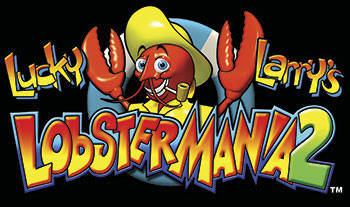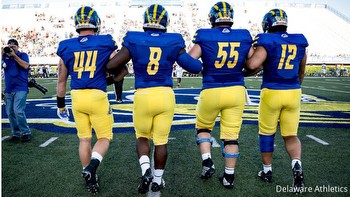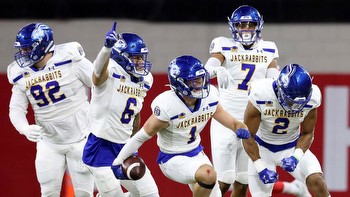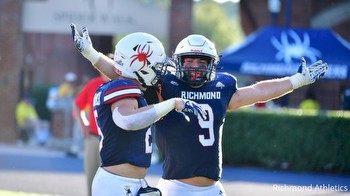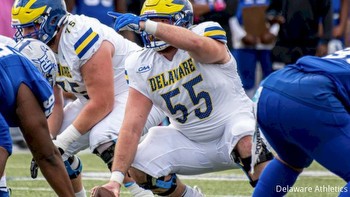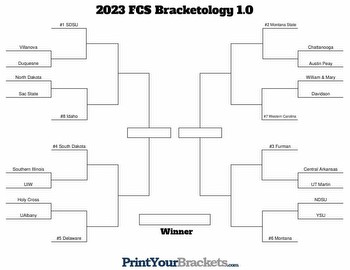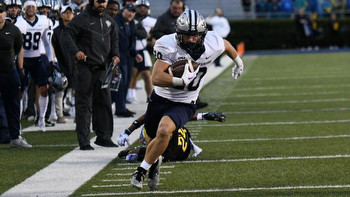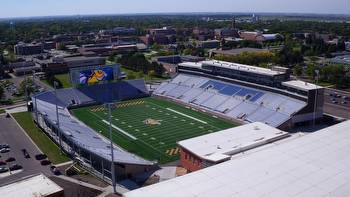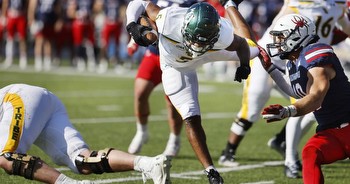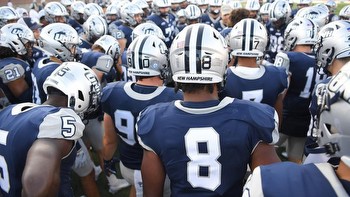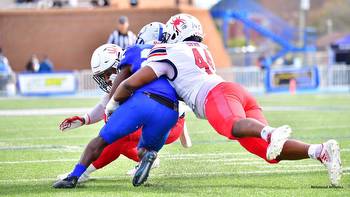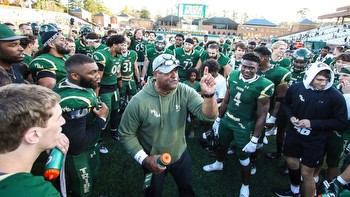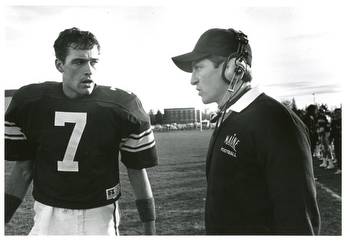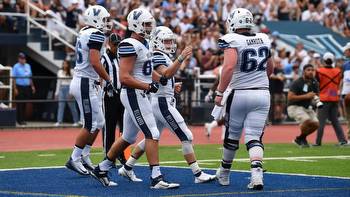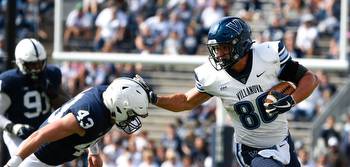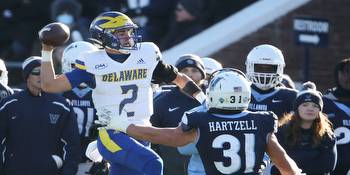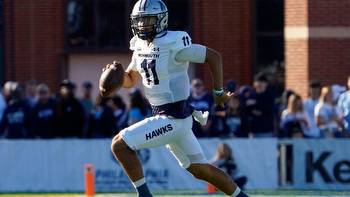Delaware is Reportedly On Their Way to Conference USA. What Does That Mean for East Coast FCS Football?
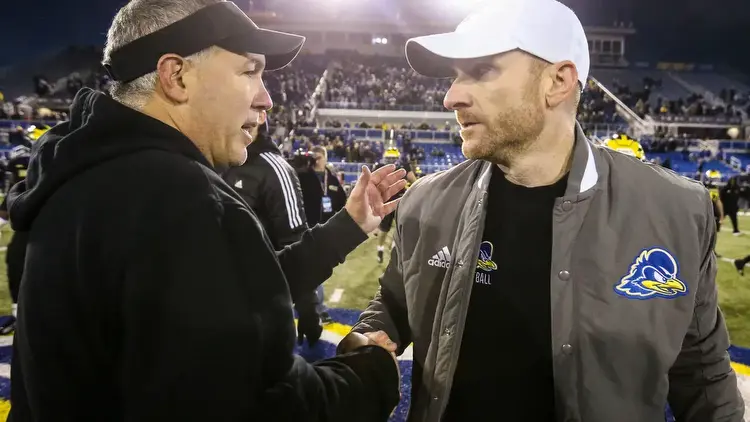
BETHLEHEM, PA – It wasn’t a total surprise, but even so, the news came down like a boulder on FCS Nation.
According to Pete Thamel of ESPN, Delaware will be headed to Group of Five football as a part of Conference USA, exiting the Coastal Athletic Association in all sports.
In so doing, the Blue Hens will be exiting the all-sports conference that they called home since 2005, and exiting the football structure now called “CAA Football” since 1986.
Delaware’s roots to the current CAA football conference date back to when it was called the Yankee Conference. Established as an all-sports conference for the New England land grant colleges, the six charter members of the Yankee Conference included Connecticut, Maine, Massachusetts, New Hampshire, Rhode Island and Vermont.
Upon the formation of Division I-AA football in 1978, the Yankee Conference disbanded all sports except for football, and Delaware was admitted to the conference in 1986. When administration of the football operations of the Yankee Conference first went to the Atlantic 10 and eventually the CAA in 2007, Delaware was one of the linchpin members of the football conference throughout. That relationship will finally be at an end after the 2024 season.
Today. Delaware has seen CAA football change drastically from its roots as a Northeast-based conference to a sprawling 15 team concoction that is a mishmosh of different schools stretching from Buies Creek, North Carolina (Campbell University) to Orono, Maine (University of Maine).
Though its membership has always been fluid – James Madison, Old Dominion and Georgia State at various times have been members, as well as VCU in basketball – the loss of Delaware is one that cuts much deeper than those.
That’s because Delaware has always felt like one of the foundational blocks of the football side of the house and appear to have been one of the architects of shifting the conference’s affiliation to the CAA from the Atlantic 10. “We are pleased to be able to have all of our sports teams under the banner of one conference for the first time since 1970,” Delaware Director of Athletics Edgar Johnson said at the time. “The CAA is an outstanding conference and having all of our sports there will be a plus for both the University of Delaware and the CAA. We are now able to brand our athletics program with one conference logo.”
Additionally, Delaware’s departure means that four of the six institutions that won FCS National Championships for the conference are no longer in FCS or with the CAA. Old Dominion, James Madison, UMass and now Delaware are gone, and only Villanova and Richmond – neither of them all sports members of the CAA – remain as former National Champions.
Seen in retrospect, the many moves the CAA has made in the last few years seems to have been in anticipation of this day. Adding Hampton, North Carolina A&T, Elon, Campbell, Albany and Monmouth over the years might be seen by some to be the reason why Delaware might have wanted to leave, but I think that they were proactive moves to make sure the conference survived after what essentially is a founding member left CAA Football.
And it honestly feels like the end of an era in Eastern Football, with the evolution of the Yankee Conference signifying its changes. First, it was an all sports conference of small Northeast land grant states, then morphed into a Northeast-based power football-only FCS conference. First a powerful basketball conference took over its administration, then the CAA took it over in a bid to become a regional power stretching all along the Atlantic Coast. Now, a new page will be turned, like it or not. The only thing that’s for sure is that it won’t be the same.
Probably the first, main effect the move has involves Villanova, Delaware’s biggest football Rival and traditional season ending game – The Battle of the Blue will almost certainly be no more.
To those who don’t live in the area, you might be forgiven if don’t understand the fierceness of the Rivalry between Delaware, a land grant research university, and Villanova, a private Jesuit institution who is better known for NCAA men’s basketball championships than their FCS National Championship.
But their proximity and a “David vs. Goliath” narrative between the two schools – Delaware being the “David”, the small-college program vs. Villanova’s “Goliath”, the major-college program – meant it was a big time regional game that always packed the house in the 1960s and 1970s.
Their Rivalry would survive Villanova’s disbanding of the program after the 1980 season, and be the first opponent to circle on their schedule when the Wildcats resumed football in 1988. Reimagined as a I-AA program in football only, the Yankee Conference eagerly invited Villanova as members, where Delaware was waiting as a fellow league member.
It cannot be emphasized enough how important how important a season-ending Rival can be for a football program.
Even when Montana, Montana State, Lehigh, Lafayette, Grambling, Southern, Harvard or Yale struggle, they always have a season-ending game with a big time atmosphere to close the regular season. For Villanova, the absence of their Rival for the first time they reinstated football will be missed terribly.
Worse, there isn’t really any other nearby FCS school that seems to fit what Delaware was to the Wildcats. Monmouth and Towson are pretty good CAA programs, but they’re not Delaware. Penn is in Villanova’s backyard, but the Wildcats haven’t seemed to have much interest in playing the Quakers in recent years. Lehigh and Lafayette have their own Rivalry, and Bucknell and Georgetown’s programs are light years behind the Wildcats football program in all ways.
It’s also worth looking at the geography of the CAA that remains.
In 2024, Bryant University will join the CAA, putting the conference at 16 teams, and Delaware will exit at the end of 2024, returning the CAA to 15 teams.
This will still make the CAA a very sprawled out conference from North Carolina to Maine, but they critically will remain with a majority of all-sports CAA members (nine in total – Bryant, Campbell, Elon, Hampton, North Carolina A&T, Monmouth, Towson, Stony Brook and William and Mary. Of those nine, only William and Mary has been an all-sports member since 2007.)
The schools of the CAA could decide to stay at a very unwieldy 15 team conference – whose problems were very evident as Richmond won a co-share of the CAA “championship” somehow without playing FCS playoff teams Albany, Villanova or Delaware – or they could force a change.
Here are some options.
- Expand to an even 16 teams and possibly split into divisions, or even pods. While a 15 team conference is near impossible to sustain in the long term for football, a 16 team conference at least has the benefit of being able to break up into an even number of groups for easier scheduling. It could be done as 8 team divisions or 4 team pods. While the FCS playoffs makes a CAA championship game impractical, it still could theoretically be done.
- Evict the non-all-sports-conference members and have a nine team conference where everyone plays one another. It would seem unlikely that the conference could evict Albany, Maine, New Hampshire, Rhode Island, Villanova, and Richmond, but it would be a clean way to circle the wagons and force the CAA football schools to find synergies together as all sports members. If something like that happened, Villanova and Richmond could possibly consider the Patriot League, but it would be a non-starter unless the Patriot League adopts drastic changes to their current redshirting and graduate student rules, among other things. As for the other four, it’s possible they could snag Merrimack and maybe even Sacred Heart and form a six team America East football conference, but it would be a far cry from what the CAA was.
- Form an association with America East, put a line above or below Philadelphia, and have an association of two football conferences. An easier idea than eviction would be to take all the Northeast schools (Albany, Bryant, Maine, New Hampshire, Rhode Island, Monmouth, and Stony Brook) and have them be “America East Football”, and have the Southern schools (Elon, Richmond, Hampton, William and Mary, Campbell, North Carolina A&T, and Towson) be “CAA Football”. Both “conferences” should probably have autobids. Depending on whether a Southern school (Charleston Southern, Gardner-Webb, Howard) or a Northern school (Robert Morris, Sacred Heart, Merrimack) joins, Villanova could be in either the “America East” or “CAA” – or Villanova could decide to go elsewhere, leaving both sides with 7 schools.
The bigger issue, though, is what this means in the long term for Northeast FCS football.
As a fan of an FCS program in the Northeast, there has been a steady march of strong FCS programs out of FCS and into FBS (with mostly bad results, it must be said). In the last 30 years, UMass, UConn, Buffalo, James Madison, Old Dominion, Georgia State and now Delaware will have left FCS.
Additionally, CAA schools like Northeastern and Hofstra have pulled the plug on their programs in order to concentrate on basketball, and an entire Northeast based football league, the MAAC, disbanded their football conference as well as five of their college football teams.
When you add to that the seemingly self-imposed exile the Ivy League has imposed on itself regarding FCS, the landscape seems thinner than ever. Even the fact that schools like Robert Morris, Monmouth and Bryant had joined or have joined the Big South Conference feels symbolic as to the Northeast’s football thinness.
There are many institutional reasons for the decline of FCS football in the Northeast that mirror the national trends. Schools down South at all divisions of football are more likely to have the college football culture and stop-at-nothing obsession of throwing money and resources at programs and players at the expense of education, and the students and their families seem to not mind being soaked with more and more athletics fees to feed them.
But it’s still striking to think that when the CAA was formed in 2007, the Atlantic 10 was seen as the most powerful conference at that time, boasting UMass, Delaware and James Madison as national champions in a ten year span. Even when they didn’t win A-10/CAA schools were fixtures in the semifinals. While the MAAC was unhealthy, there was no shortage of choice for FCS out-of-conference games if you were in the Northeast. That doesn’t feel true anymore.
As the Dakotas rose, too, it was at the expense of the A-10/CAA’s dominance. While James Madison did win a national championship in the last twelve years, unless Albany, Richmond or Villanova make a run to the title this season, the only current CAA team that would have made it to the neutral-site finals is Towson, and that was a decade ago.
Delaware’s move to Conference USA is unlikely to change this trend. I don’t believe Tubby Raymond field long-term will be selling out home games vs. UAB with about a dozen UAB fans making the trip to Delaware in November on a Wednesday. In fact, more and more Conference USA football is starting to resemble the old idea of an “FCS Superconference” floated decades ago that could migrate to FBS en masse, featuring Delaware, Old Dominion, Sam Houston State, Jacksonville State and Liberty.
But it might keep Delaware’s place in the NCAA Men’s Basketball Tournament alive, should the powers-that-be decide to change the access the smaller conferences have. And it will keep Delaware’s football team playing football, just without any rivals nearby to sustain regional interest.
And it is in that which I think Delaware’s move is detrimental to college football.
It epitomizes a move towards longer travel times for everyone, and chartered flights for games many fans can’t and won’t attend. It means marching bands won’t travel often, if at all, and lead to cloistered game atmospheres that play only to the home audience.
The Battle of the Blue was a great Rivalry because the fans of both schools could attend the tailgates and the game, both bands could play, more fans could watch, and everyone would be home by 10PM. The bond was so strong, in fact, that it survived Villanova disbanding their program and allowed the Wildcats to rebuild it into an FCS National Championship-winning team, as it did Delaware.
That type of story will not happen in Conference USA. Rivalries might form, against all odds, but they won’t have that brotherly, intimate feel that this one had. Delaware fans might really long for matchups like this when the Blue Hens are traveling to Florida International in October.
The Northeast need to have more regional rivalries like this, not less.
Northeast football wins when Harvard/Yale, Lehigh/Lafayette, Howard/Hampton, Maine/New Hampshire and other Northeastern-area schools play in Rivalries that matter, preferably at the end of the regular season, and in a world where corporate interests try to globalize Power 5 football, such things can make Northeast football remind people what makes the sport great in the first place.
That’s what the remaining FCS conferences need to do – no matter how it comes about, and no matter what structure it ends up becoming at the end of the day. Rivalries are what they are about, whether they realize it or not.
